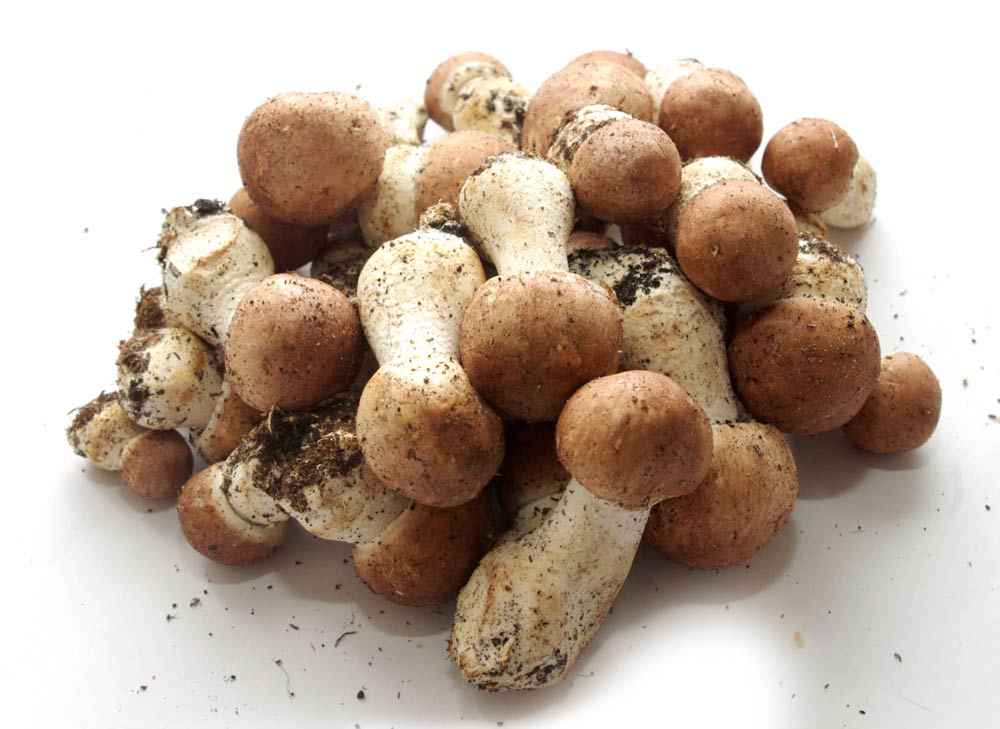Agaricus blazei Murill (Japanese Himematsutake, Chinese Ji Song Rohg, in Brazil Cogumelo do Sol, almond mushroom, Agaricus brasiliensis, Royal sun mushroom) belongs to the mushroom family. Agaricus is native to South America. Its occurrence in nature has always been very limited to an area near the small village of Piadade in the province of Sao Paolo. The natives there have used Agaricus since time immemorial not only as a nutritious food, but also as a remedy for many ailments. The mushroom has an excellent taste and, as its English name suggests, smells like almonds. The mushroom remained hidden to the rest of the world until 1945 when William Alphonso Murill described it, but the premiere of Agaricus came later. In 1960, Takotoshi Furumoto began researching it, and in 1965 Agaricus made its way to Japan. So far, only as a subject for further research. Agaricus was identified and included in the fungal taxonomy in 1967 by the Belgian botanist Hainemann. Thanks to intensive experiments investigating not only the composition but also the effects of Agaricus, it became a very popular mushroom. And it is no wonder that it is in Japan, Korea, China and Taiwan. Today, Japan is one of the largest producers of Agaric. Because it is relatively easy to grow, the mushroom is not very demanding, and it is produced in large quantities, its price is not too high compared to, say, Cordyceps sinensis, which is worth its weight in gold.

Agaricus is a member of the family Agariaceae, which is Czech for roasting mushrooms. It is a smaller mushroom that has a large cap (2-12 cm in diameter) that is initially white or cream in colour (at that time it is convex, more closed), later the colour changes to brown-gold and straightens and frays at the edges. The hat is covered with small scales. The underside of the hat is made up of lamellae which are pink to brown in colour. When cut, the mushroom is firm and white, later turning yellow to orange on the cut. Agaricus is used in fresh and dried form in the kitchen like other mushrooms. It can therefore be used in various meat and vegetable mixtures, fried, used in sauces, soups.. . However, its virtues are not only used in the kitchen, but its composition makes it a mushroom with great potential to help humans.
Carbohydrates
It is typical for all mushrooms that their main component, excluding water, is carbohydrates, i.e. sugars. Most often these are polysaccharides, which are large molecules composed of many unit sugars. They have a main chain that branches out. According to the size and branching, polysaccharides have different effects. The most well-known polysaccharides are undoubtedly beta glucans, which are good immune system boosters. In Agaric I am mainly beta glucans, both (1-6)-beta and (1-3)-beta, (1-4)D (e.g. (1, 4)-β-D-galactan). Alpha glucans (e.g., (1, 5)-α-L-arabinan and (1, 4)-α-D-galacturonan) are also represented in smaller amounts. In addition to these polysaccharides, Agaricus also contains insoluble polysaccharides, i.e. fibre, which supports peristalsis and serves as a food source for symbiotic bacteria in the gut. It is not only polysaccharides, unbound sugars, i.e. disaccharides or monosaccharides, are also present in Agaricus. One of these is mannitol. This has its place in medicine as it helps to lower blood pressure and reduce swelling. It is used, for example, in patients with increased intracranial pressure. Mannitol promotes the elimination of fluids from the body. Other sugars in Agaric are rhamnose, arabinose, xylose, fucose, etc.
Amino acids and proteins
Agaricus is not only a source of polysaccharides, but also of amino acids and proteins. In Agaricus there are 16 non-essential and essential amino acids, i.e. those that the human body cannot produce itself and depends on food for their supply. The highest concentration of the amino acid arginine is found in Agaric, followed by glycine, glutamic acid, alanine, etc. Agaricus contains not only amino acids, but also final proteins. These are mainly enzymes that help break down plants and wood so that the fungus can obtain nutrients. These include lactases, endo-beta-1,3 glucanase, enzymes that degrade lignin... these enzymes are so powerful that they are also able to degrade many substances that are toxic, carcinogenic and mutagenic. These substances are often released into nature, into the soil, the water... and thus into the food we eat. These are pesticides, herbicides, etc., which are very difficult to degrade. Agaric' s enzymes can break these substances down into smaller "parts" that are no longer toxic. One of the herbicides that Agaricus breaks down is metsulfuron, for example.
Fats, fatty acids
Fatty acids, i.e. fats, are also present in Agaricus. Unsaturated fatty acids predominate over saturated fatty acids, which is beneficial to health. The most abundant unsaturated fatty acids in Agaric are linoleic acid and saturated palmitic acid. Together, these two make up 85% of the fats in the mushroom. The other saturated fatty acids are linoleic, stearic and pentadecanoic.
Other components of Agaric
The composition of Agaric is very varied. It is impossible not to mention the phenolic compounds, which are powerful antioxidants and can also induce apoptosis in cancer cells. These include gallic, syringic, cinnamic, caffeic, ferulic, pyrogallol, etc. Flavonoids include compounds such as catechin, hesperetin, myricetin, etc.
Steroid compounds are also represented in Agaric. One of the main ones is ergosterol, from which vitamin D2 is formed. Another steroid compound is cerevisterol, the ergosterol derivative agarol and also blazein.
Similar to other mushrooms that are used for purposes other than satiation, terpenoids are also present in Agaric, which are also antioxidants and have many other benefits for our bodies. This group includes blazeispiroles A, B, C, E and F.
There are also organic acids in Agaric, which also give it flavour. These include oxalic, malic, acetic, formic and many others.
We would also like to add that vitamins can be found in Agaric, especially B vitamins (B1, folic acid, B2, B12), the aforementioned vitamin D and tocopherol alpha and gamma, which is vitamin E. Vitamins are also supplemented with minerals such as potassium, calcium, magnesium, zinc, copper, selenium, etc.
Agaricus also harbours one toxic substance in it like other mushrooms. This is agaritin. However, the content is very small and there is no risk with normal consumption. Agaritin is also degraded by storage for 5 days at 2 degrees Celsius or by freezing, this degrades about 70%, canning destroys 90% and cooking degrades the whole volume.
We have already mentioned that Agaricus is very popular, not only as a food. Many studies have been carried out to show the effects of Agaricus, which is why a standardised preparation called AndoSan (82% Agaricus, 15% Hericium and 3% Maitake) has been created. It is produced by a Norwegian company and clinical trials have been carried out with this preparation in patients with Crohn's disease and ulcerative colitis, which are chronic inflammatory bowel diseases.
 Vital mushrooms PRO (16)
Vital mushrooms PRO (16) MyTao Edition (14)
MyTao Edition (14) Vital Mushroom Extracts (25)
Vital Mushroom Extracts (25) Combination of mushrooms and herbs (19)
Combination of mushrooms and herbs (19) Traditional recipes (5)
Traditional recipes (5) BIO vital mushrooms powder (9)
BIO vital mushrooms powder (9) Syrups (12)
Syrups (12) Dried vital mushrooms (6)
Dried vital mushrooms (6) Honey products (5)
Honey products (5) Vitamins (4)
Vitamins (4) BIO green food (2)
BIO green food (2) Other (2)
Other (2)

